 The main function of vision is to transmit visual information about the surrounding world in the form of electrical signals to the brain. The eyes are connected to the central nervous system by optic nerves, due to which the person reacts to the image visible to them quickly.
The main function of vision is to transmit visual information about the surrounding world in the form of electrical signals to the brain. The eyes are connected to the central nervous system by optic nerves, due to which the person reacts to the image visible to them quickly.
And any deviation in the work, the structure of the organ of vision can lead to sad consequences. One of them is anisocoria - a condition where there is a difference in the size of the pupil. Thus one eye works normally, in another the pupil does not react to light, remaining in the fixed size.
Pupillary reflex, its value for a full-fledged vision
The visual image perceived by the eye before reaching the retina passes the cornea, pupil, lens, vitreous. Depending on the brightness of the light flux penetrating the eyeball, the size of the pupil in the iris changes.
The muscle fibers have a responsibility to narrow or widen this dark hole in the iris. The sphincter muscle for narrowing it surrounds the opening with circular fibers, and the dilator is formed by radial muscle fibers that extend like the spokes of a wheel. Both muscles move under the action of parasympathetic and sympathetic nerves.
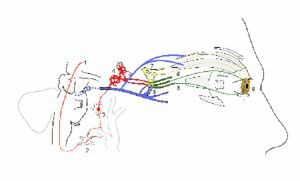
Bright light leads to a reduction in the iris, and the light stream entering the eyeball becomes smaller. With a decrease in the level of illumination, the activity of nerve fibers is inhibited, the sphincter relaxes, the pupil becomes enlarged.
With a high degree of physical exertion, a surge of emotions - dilator fibers dilate the pupil. Nerves and muscles set it in motion, help to form a clear image, when a person looks at nearby objects or tries to see something in the distance.
The forms of the disorder, their peculiarities
The origin of anisocoria can be different, that is why they distinguish both the congenital form of the disease and the acquired one.
Abnormal structure of the iris is associated with abnormalities in the muscles and nerves of the eye. If the difference between the pupils is small, is not more than one millimeter, this is considered the norm, especially since it does not affect visual acuity. Statistics say that every fifth inhabitant of the planet has a physiological abnormality.
In case of impaired nervous or muscular conduction, when the pupil does not respond to the brightness of the light flux, it is necessary to consult a doctor. After all, this can be a manifestation of various types of diseases, both of an ophthalmological nature, and of a neurological, traumatic or infectious one.
Provoking causes of
Pathological changes in the iris lead to a lack of pupillary response to light, accommodation, or the ability to acutely see objects at any distance. Causes and diseases, in which the pupils become different sizes and develops anisocoria, many:
- The overly dilated pupil is associated with oculomotor nerve lesion .There is a violation due to an aneurysm, acute disturbance of cerebral circulation, a brain tumor.
- Parasympathetic denervation often has the infectious nature of .Herpes zoster affects the eye socket, and the pupil reacts weakly to light or the reaction occurs at a slowed pace.
- A different response to light in pupils occurs in patients with meningitis, tick-borne encephalitis .
- The syndrome, diagnosed in the patient, is associated with degenerative processes occurring in the parasympathetic neurons of the ciliary ganglion. The pupil is reduced tendon reflexes, the pupils become different in size and there is blurred vision.
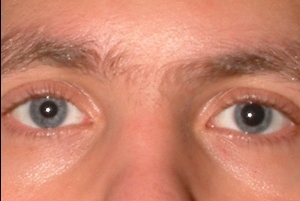
- Sympathetic innervation of the eye is diagnosed with lymph node enlargement in the neck region, a tumor located in the base of the skull, carotid artery thrombosis .To damage the neuron leads and cancer tumor in the upper part of the lung. In this case, the reaction to the light pupils is not broken, but looking at the patient, there is a feeling that one eyeball is located in the orbit deeper than the other. This condition is called Horner's syndrome or simple anisocoria. It can be accompanied by pain in the face or giving up in the hand, circulatory disorders in the vessels of the brain.
- A sharp dilatation of the pupil followed by a reduction in all visual reactions occurs when glaucoma results in ischemic condition of the iris.
- An abnormal pupil shape acquires as a result of a mechanical damage to the organ of vision or a traumatic brain injury .In such cases, inflammation of the iris and choroid of the eye arises.
- Damage to the visual centers located in the cerebral cortex also causes a sharp dilatation of the pupil. After stroke such deviations are also possible.
- The pupils may not widen or narrow after receiving medicines used in medicine - Atropine, Pilocarpine, Physostigmine. One-sidedly changes the size of pupils after using drugs: Cocaine, Amphetamine.
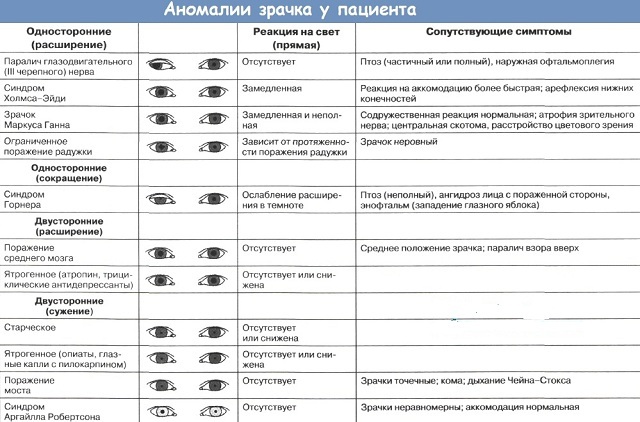
Anisocoria in children and adults: features of
Congenital impairment in the pupil's work can be seen in infants, but this can be a physiological phenomenon that has been going on for several years.
To develop a dysfunction of the pupil of one eye can result from birth trauma, genetic predisposition. If the parents of the child found that his pupils are unevenly located or of different sizes, then one should consult a doctor and check if there are concomitant diseases, such as the lower eyelid, strabismus, restriction in the movement of the eyeball.
In children older than a year, a symptom of different pupils may appear as a result of a brain tumor, an increase in intracranial pressure.
In such cases, the pupil decreases in diameter in a dark room, although the child does not suffer from sharpness of the image, he can see well that is far or near. Anomaly of the pupil is manifested by impaired vision, the appearance of double vision in the eyes, fear of light. This should alert the parents of the child, and then a doctor's visit is mandatory.
 Causes and diseases that provoke different pupils in size can manifest themselves both in young people and adults after fifty years.
Causes and diseases that provoke different pupils in size can manifest themselves both in young people and adults after fifty years.
The appearance of malignant or benign brain tumors is a phenomenon common in young women. The pupil's response to stimulation by light in such cases is delayed, but when viewed from afar it slowly begins to expand. The pathological phenomenon is combined with the blurred vision.
In elderly people, the difference in the pupils is especially noticeable after a stroke, increased intracranial pressure.
Complex of therapeutic measures
Since anisocoria is only a symptom, the treatment is aimed at getting rid of the cause of its occurrence.
Hematomas, brain tumors derived from birth injuries or after an accident, lead to the fact that the patient often sees impaired conduction of the optic nerve, damage to the fibers of the muscles of the iris.
In this case, the influence of physiotherapy on the restoration of tissue cells is great due to the strengthening of their nutrition, stimulation of metabolic processes. 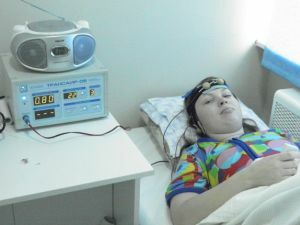
Magnetic waves promote improvement of cerebral circulation, normalize blood pressure. Infrared radiation helps to relieve muscle spasms. Activates the processes inside cells, tissues, aimed at regeneration, sessions of electrical stimulation.
The prescription of medicines occurs after a complete examination and the cause of the deviation is identified. The main efforts are directed to the treatment of the underlying disease, the sign of which is the constriction or dilatation of the pupil in one eye.
Among the prescribed drugs: corticosteroids for the removal of inflammation, antibacterial agents that actively affect pathogenic microorganisms.
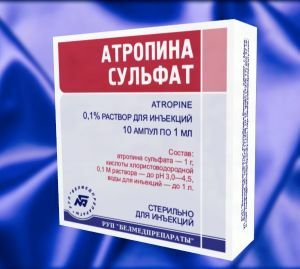 Anisocoria caused by trauma to the eye is eliminated with medications that relax the muscles of the iris. These include drops of Irifrin, Atropine. Ophthalmic drug Cyclomed and Midratsil, which belongs to the group of anticholinergics, is used to expand the pupil.
Anisocoria caused by trauma to the eye is eliminated with medications that relax the muscles of the iris. These include drops of Irifrin, Atropine. Ophthalmic drug Cyclomed and Midratsil, which belongs to the group of anticholinergics, is used to expand the pupil.
From folk remedies inflammation of the eye membranes removes the liquid aloe extract used for lotions. An infusion of carrot mix and dry nettle, taken in the amount of two tablespoons, is prepared from half a liter of boiling water. After two hours of drinking, this daily treatment will strengthen the eyesight.
Correctly selected treatment will get rid of the disease. In some cases, surgical intervention is also necessary.
Consequences of a violation of
Disturbances in the functioning of the eye muscles and nerve fibers can cause the patient to develop inflammation of the iris, irit. Usually they occur in people up to forty years, less often in children and the elderly.
During the course of the pathological process, the pattern of the shell changes, acquiring fuzzy, the visual acuity decreases. The patient feels constant pain in the head, giving to the temporal region. Chronic form of inflammation can result in atrophy of the eye.
With diplopia, or double vision, the image is blurry. This greatly tires the person, he starts to distinguish badly objects, feels discomfort, dizziness. It will help to identify the cause and prescribe a treatment for a neurologist and an ophthalmologist.
Different pupils in size often lead to strabismus, developing in children due to uncoordinated activity of the muscles of the eye. The organ of vision that mows does not participate in the visual process is lazy. To cure this form of pathology in children is possible with the help of medicines, wearing special glasses.
Avoiding the unpleasant consequences of acquired anisocoria is the task of specialists, to which the patient who has lesions of the nerve fibers of the eye must turn in time.



